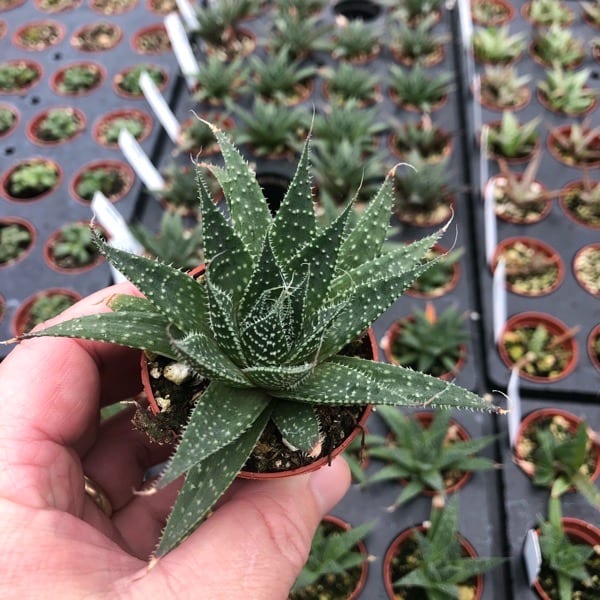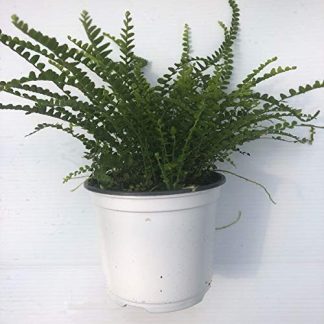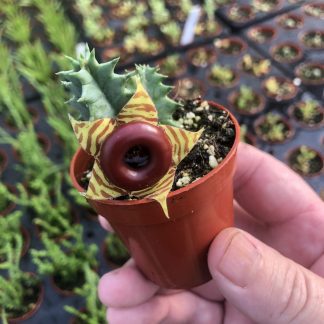Description
Aristaloe aristata: The Lace Aloe Guide
The Lace Aloe, known scientifically as Aristaloe aristata, is a compact succulent prized for its lacy, speckled leaves and resilience. Despite being called an aloe, it belongs to a closely related group and combines the charm of aloes with the toughness of hardy succulents. This plant is a favorite for small gardens, rockeries, and containers because of its tidy rosette shape and minimal care needs.
A Closer Look at Lace Aloe
Distinctive Appearance
Lace Aloe forms dense rosettes of triangular leaves edged with soft white spines. The leaves are deep green with lighter speckles, giving them a frosted look. Their tips often bear delicate hair-like filaments, resembling lace — the inspiration for its common name.
Seasonal Blooms
In late spring to summer, mature plants send up tall flower stalks topped with tubular, orange-red flowers. These blooms attract hummingbirds and pollinators, adding seasonal color to the plant’s understated charm.
Growing Conditions
Light Needs
-
Thrives in bright, indirect sunlight or partial sun.
-
Outdoors, it prefers morning sun with light afternoon shade.
-
Indoors, place near a sunny south- or east-facing window.
Soil Requirements
-
Requires well-draining soil such as cactus or succulent mix.
-
Amend garden soil with sand or perlite to prevent root rot.
Watering Routine
-
Water deeply but allow soil to dry between waterings.
-
Reduce watering in winter when growth slows.
-
Overwatering is the most common cause of failure.
Temperature and Hardiness
-
Hardy to USDA Zones 8–11.
-
Tolerates light frost briefly but prefers protection from prolonged freezing.
-
Ideal temperature range: 55–85°F (13–29°C).
Fertilization
-
Use a balanced succulent fertilizer diluted to half-strength.
-
Feed during active growth (spring and summer) every 4–6 weeks.
-
Do not fertilize in winter dormancy.
Potting and Repotting
-
Repot every 2–3 years or when roots outgrow the container.
-
Choose shallow pots with drainage holes.
-
Refresh soil during repotting to maintain nutrient balance and aeration.
Propagation
-
Offsets (pups): Easily separates from the mother plant. Allow offsets to callus for a day before replanting.
-
Seed: Less common but possible; requires warm temperatures and patience.
Common Problems and Solutions
Soft Leaves or Rot
-
Caused by overwatering or poor drainage.
-
Remedy: Let soil dry and improve drainage.
Leaf Tip Browning
-
Often from underwatering or low humidity indoors.
-
Remedy: Adjust watering schedule and move away from heaters.
Lack of Blooms
-
Usually due to insufficient light.
-
Remedy: Provide more sun exposure in growing season.
Uses in Garden and Home
-
Rock Gardens: Its compact form fits perfectly among stones.
-
Container Planting: Ideal for patios, balconies, or sunny windowsills.
-
Pollinator Planting: Flowers attract hummingbirds and beneficial insects.
Tips for Success
-
Avoid heavy clay soils.
-
Water sparingly in winter dormancy.
-
Protect from harsh afternoon summer sun in very hot climates.
-
Rotate indoor pots for even growth.
Why Grow Lace Aloe?
This plant blends beauty with resilience. Its patterned leaves stay attractive year-round, and its flowers bring a cheerful burst of color when many other succulents are quiet. It’s low-maintenance, adaptable, and forgiving — a plant that rewards even casual care with lasting beauty.
Bringing Lace Aloe into Your Collection
With its modest size and charming design, Lace Aloe works anywhere — a desk, windowsill, or small garden corner. It’s perfect for beginners wanting a fuss-free succulent or collectors seeking a textured accent plant. Once you grow one, it often multiplies, giving you extra plants to share with friends.




